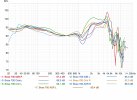Like always, you say a lot without really saying much and manage to evade all the arguments given.
If you really doubt that pinna interaction is involved in generating soundstage, just name me an IEM (there exist several thousands by now) that has a comparable soundstage to the Sennheiser HD 800. If you are not able to do this, you don't have a strong case.
Well for a start the main problem, as I said, is that "soundstage" has yet to receive a commonly accepted operational definition, so whatever I'd call "soundstage" might not correspond to whatever you call "soundstage" and isn't testable. Naming such an IEM would therefore simply be my own opinion, not a fact.
But if you want my totally subjective and useless opinion : any IEM that I can reliably EQ to deliver a specific FR at my eardrum ?
You also, probably deliberately, did not comment on my second argument. Take the Sennheiser HD 800 and EQ it to any FR you like. It will still have a huge soundstage, so FR has no significant on that.
I've owned a pair of HD800 (did you ?) and I could easily EQ it in a way that ruins anything that I'd subjectively call "soundstage" from it. But that's just my opinion. And what's bolded also is an opinion.
Your measurements of the IEMs are off.
Well at least two out of the three groups of traces are, for certain - if not all of them. But why ? And how are they off, but in a very repeatable and reproducible way, even without moving the IEM ?
So maybe the cheap device from Aliexpress is trash or you are doing it wrongly, what kind of argument is this? There are many different people out there that manage to generate FR measurements which are very similar one to each other, maybe you have to learn from them? Compare Amirs IEM measurments with crinacles and with, for example, Super*Review ot HBB, they are mostly very similar.
The same IEM in the same mode (well, kinda, but that's complicated), measured by various sources (Crinacle, 0dB, Sean Olive, Aregina, Hypethesonic, Precog), including some alternate takes from the same source. Now I have to come clean, I am a bit cheeky here and some (but not all) of the difference comes from a volume dependent EQ.
But as I said my own measurements were made at the same volume (and also the exact same mode, well kinda, but that's complicated). Also, it includes for two sources (0dB, Hypethesonic) the same sample measured by the same operator on the exact same test rig, producing different results (particularly at 3kHz for example, which is not related to the volume dependent EQ).
The doublets :
On the other hand, one of my Chu measured inside my clone coupler, vs. various sources (somewhat decent agreement in comparison - all three of my samples measure similarly) :
So what happens with the first IEM ? How do you know which measurement is representative of what is happening in your ears ? How do you know which one to pick if you wanted to EQ these IEMs to a target ?
I fully admit that I'm having fun here by throwing into the mix possibly one of the trickiest pair of headphones ever to measure, but hopefully that makes you think twice about taking IEM measurements at face value.
Ok, so lets start slowly. Do you agree that two IEMs, which measure the same (including one being EQed to the other one and than both being measured), will sound the same to a specific individual (with his own ECRTF ( ear canal related transfer function)?
If they're passive, seal well, and even more so if I use the same tip for them, then I can tell you : mostly kinda sorta yep up to about 4kHz, but possibly not above on a systemical basis.
If they're active with a feedback mechanism : nope (and I've already given you an example).
Last edited:



